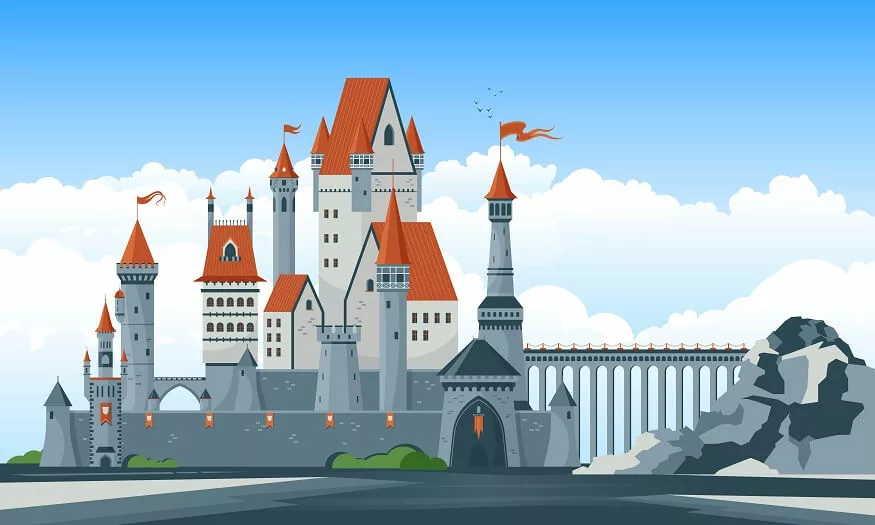Medieval castles stand as monumental symbols of an era characterised by chivalry, feudalism, and grandeur. These imposing structures, scattered across Europe, tell tales of knights, sieges, and courtly love. As we delve into the realm of medieval castles, we will uncover the fascinating history, diverse designs, and enduring features that define these architectural marvels.
The Middle Ages and Castle Origins
The Middle Ages, spanning from the 5th to the 15th century, witnessed the rise and fall of empires, feudal systems, and the construction of awe-inspiring castles. The term “medieval castle” encapsulates the essence of fortresses built during this period. These structures were not only military strongholds but also served as symbols of power, prestige, and authority.
Europe boasts an extensive array of castles, each with its unique story and design. The origins of medieval castles can be traced to the chaotic post-Roman period, where the need for protection against invasions and marauders prompted the construction of fortified structures.
Also Read: Why is it Important to Study Ancient Civilisation – Benefits
Medieval Castle Designs
Medieval castle designs were intricate, blending functionality with aesthetics. The primary objective was to create formidable defenses while accommodating the needs of the ruling elite. The architectural evolution of these structures can be categorised into several distinct phases.
Motte and Bailey Castles
One of the earliest forms of medieval castles, Motte and Bailey structures were characterised by a raised earth mound (motte) crowned with a wooden tower, surrounded by a bailey – an enclosed courtyard. This design provided strategic advantages, allowing defenders to survey the surroundings and control access.
Stone Keep Castles
As architectural techniques advanced, stone keep castles emerged. These sturdy structures featured a central stone tower (keep) surrounded by defensive walls, often equipped with battlements and arrow slits. Stone keep castles signified a shift towards more permanent and formidable fortifications.
Concentric Castles
The pinnacle of medieval castle design, concentric castles incorporated multiple layers of defensive walls and towers. This design made sieges exceptionally challenging, as attackers had to breach successive lines of defense. Beaumaris Castle in Wales is a prime example of a concentric medieval fortress.
Also Read: How art, science, and thought transformed during the Renaissance
Features of a Medieval Castle
Medieval castles boasted a plethora of features that made them both formidable and functional.
Drawbridges and Gatehouses
Entry into a medieval castle was a carefully guarded affair. Drawbridges, often spanning moats, provided a secure means of access. Gatehouses, equipped with portcullises and murder holes, further fortified the entrance, allowing defenders to control and repel potential invaders.
Keep or Donjon
The keep, also known as the donjon, served as the heart of the castle. Typically a massive stone tower, the keep housed the lord’s living quarters, halls, and, in times of danger, served as a last refuge for the castle’s inhabitants.
Battlements and Crenellations
The distinctive tooth-like parapets, known as crenellations, adorned the tops of castle walls. These not only provided shelter for defenders but also served as platforms from which archers and crossbowmen could rain projectiles upon attackers. Battlements, with alternating high and low sections, offered protection while allowing defenders to maintain a steady stream of fire.
Arrow Slits and Murder Holes
Defensive mechanisms like arrow slits and murder holes were strategically placed throughout the castle. Arrow slits allowed archers to shoot arrows at attackers while minimising exposure, and murder holes were openings in the ceiling through which defenders could drop harmful objects or hot substances onto intruders.
Types of Medieval Castles
The diversity of medieval castles extends beyond their geographical locations, encompassing variations in purpose, size, and architectural styles. Understanding the different types of castles provides insight into the multifaceted roles these structures played in medieval society.
Royal and Noble Residences
Some castles primarily functioned as luxurious residences for royalty and nobility. Windsor Castle, perched on a hill in Berkshire, England, is a quintessential example. These castles featured opulent living quarters, grand halls, and lavish gardens, reflecting the social status of their inhabitants.
Military Fortifications
Many castles were constructed with a primary focus on military functionality. These fortresses, strategically positioned to control key territories, played pivotal roles in medieval warfare. Caernarfon Castle in Wales, with its imposing walls and towers, exemplifies the military prowess of medieval castle architecture.
Border and Defensive Castles
Positioned on the frontiers of kingdoms, border castles were instrumental in protecting against external threats. These castles often featured robust defensive structures and were strategically located to monitor and repel invaders. Bamburgh Castle, standing sentinel on the Northumberland coast, exemplifies the defensive role of border castles.
Crusader Castles
The Crusades, a series of religious wars fought during the medieval period, led to the construction of castles in the Holy Land. Crusader castles, such as Krak des Chevaliers in Syria, were built to withstand the challenges posed by the harsh environment and frequent military conflicts in the region.
Also Read: What is the importance of the history of education?
10 Castles of Medieval Times
- Windsor Castle (England): Windsor Castle, located in the county of Berkshire, England has served as a royal residence for over 900 years and is renowned for its stunning architecture, including the iconic Round Tower.
- Edinburgh Castle (Scotland): Perched on Castle Rock, Edinburgh Castle has witnessed numerous battles and sieges and is now a popular tourist attraction, offering panoramic views of the city.
- Neuschwanstein Castle (Germany): Neuschwanstein Castle is a fairy-tale fortress built in the 19th century. Commissioned by Ludwig II of Bavaria, it draws inspiration from medieval romanticism and has become an iconic symbol of German castles.
- Château de Chambord (France): Constructed in the 16th century, Château de Chambord boasts a distinctive blend of medieval and classical influences, with its intricate turrets and grandeur.
- Alnwick Castle (England): Situated in Northumberland, England, Alnwick Castle is known for its imposing walls and towers. The castle has served as a filming location for various movies, including the Harry Potter series.
- Prague Castle (Czech Republic): Dating back to the 9th century, Prague Castle includes a mix of architectural styles, from Gothic to Romanesque, making it a captivating historical site.
- Conwy Castle (Wales): Built by Edward I in the late 13th century, Conwy Castle is a medieval fortress located in North Wales.
- Hohenwerfen Castle (Austria): Hohenwerfen Castle has a history dating back to the 11th century.
- Malbork Castle (Poland): Originally built by the Teutonic Knights in the 13th century, Malbork Castle served as a medieval fortress and later as the residence of the Grand Master of the Teutonic Order.
- Bodiam Castle (England): Nestled in the East Sussex countryside, Bodiam Castle was built in the 14th century. It features a picturesque setting, complete with a surrounding moat and well-preserved battlements.
Also Read: Top 10 Archaeological sites around India
For more such interesting blogs on History, visit EuroSchool.










